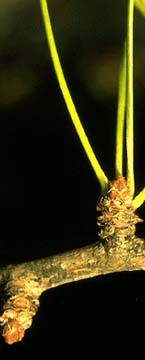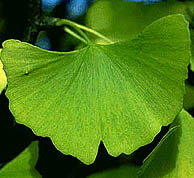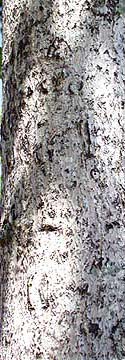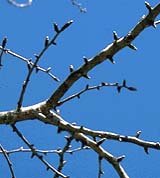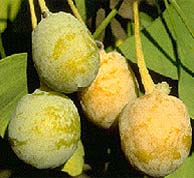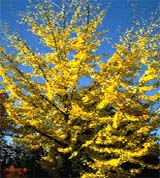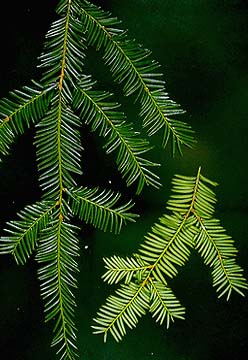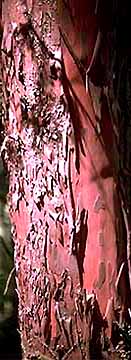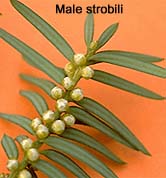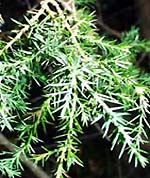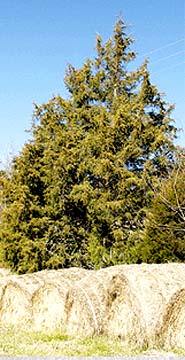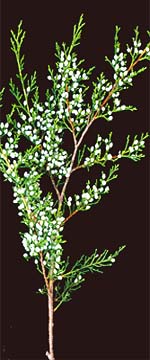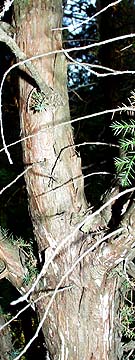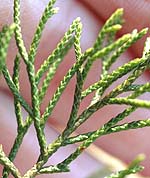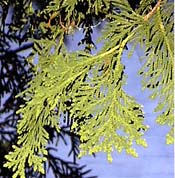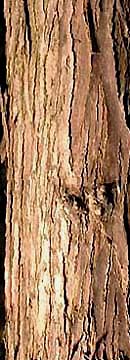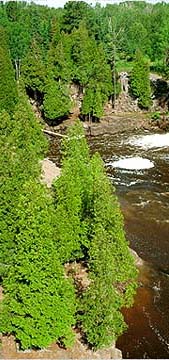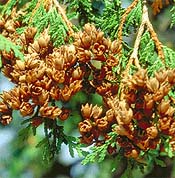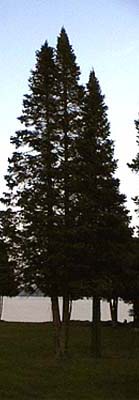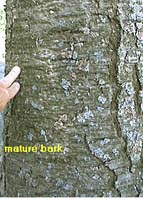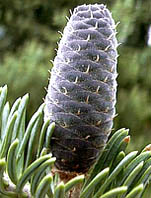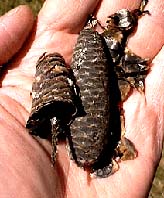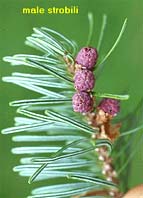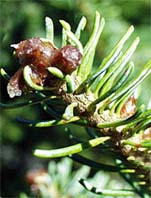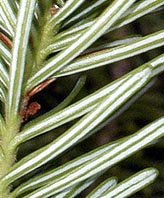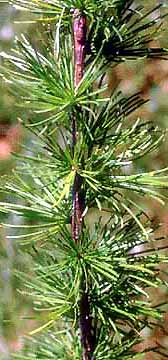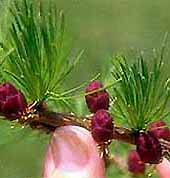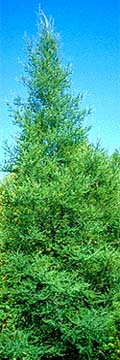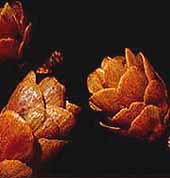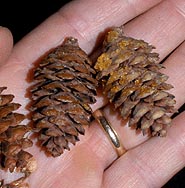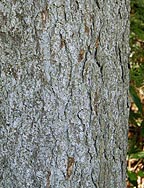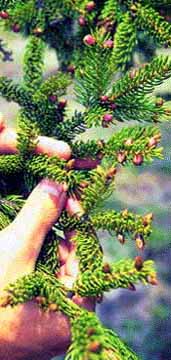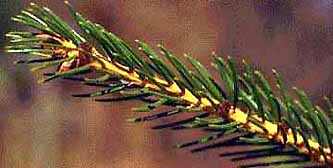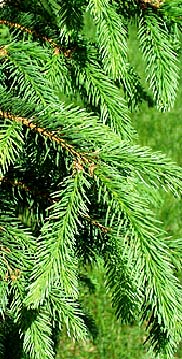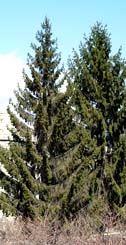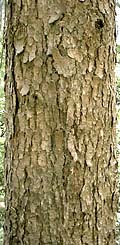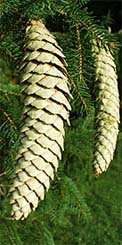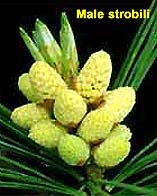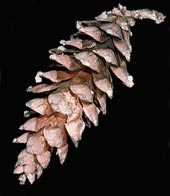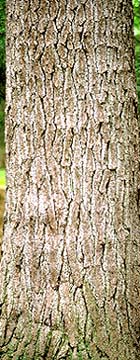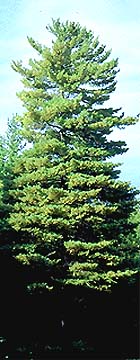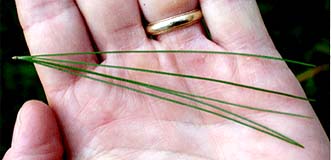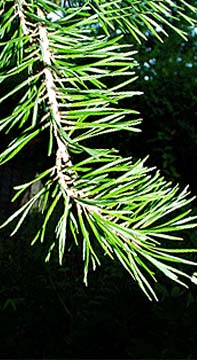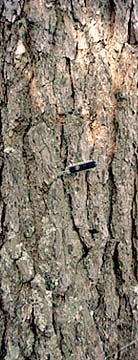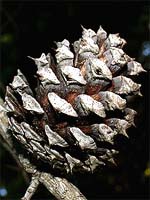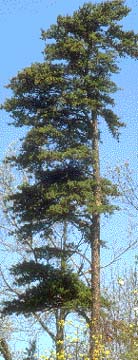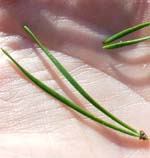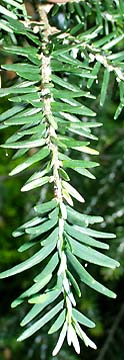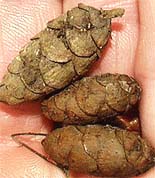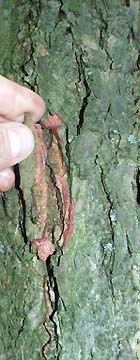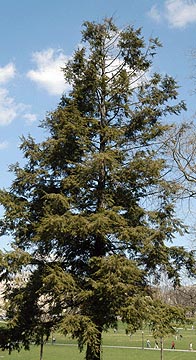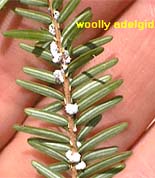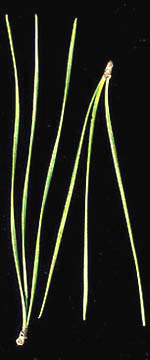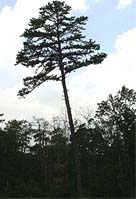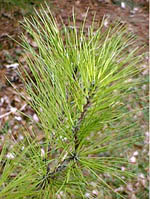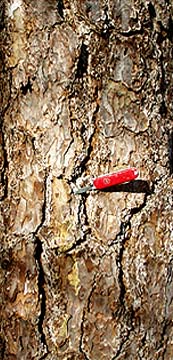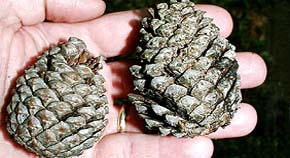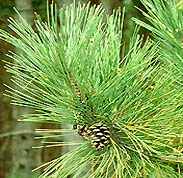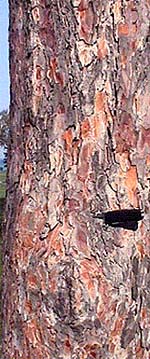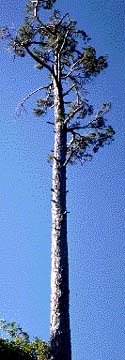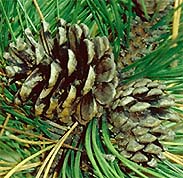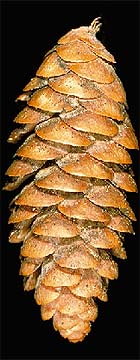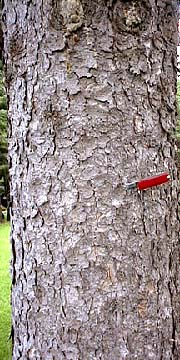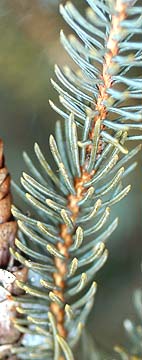Group 1 (Gymnosperm) Notes
Gymnosperm = naked seed
I. Gymnosperms are seed-bearing plants where ovules are:
1. Born on the margins of modified leaves
2. Occur at the tips of specialized short branches
3. Located in various types of strobili (cones)
II. Ovules are not:
1. Sealed in carpels--they are exposed to the air at the time of pollination
2. Not using pollen receptive structures--ovules receive pollen directly
III. Terms
Fascicle: point of connection of a cluster
2-ranked: in two vertical rows on an axis
Umbo: protuberance on the scale of a cone
Scales: part of the cone on a conifer that bears ovules
IV. Conifer Identification
Things to look for:
Needles-- clustered (how many needles/cluster)
color
length
Branches-- drooping or horizontal
white sap/powder present
white stripe along needle
Location-- upland
wet sites
Cone-- location on branch (upright or hanging)
length/width
shape (rounded/pointed near apice)
umbo presence/shape
Bark-- color and texture
Conifer Families
Ginkgoaceae
Habit: Leaves alternate or usually on short shoots (spur shoots), leaves simple, flabellate (fan shaped), palmate dichotomous venation, petioles present. Dioecious.
Ecology: Native to China. Cultivated, but not naturalized world-wide.
Use: Memory enhancer. Seeds roasted and eaten as a delicacy in China.
- Leaf: Alternate, simple, fan-shaped, 2 to 3 inches long and wide; parallel, fan-like veination, may be irregularly 2 to 3 lobed at the broad edge or just wavy, petiole long, light green above and below.
- Flower: Dioecious; tiny green males are borne on 1 inch long catkins; female "cones" are 1 1/2 to 2 inch long peduncles, bearing 1 to 2 ovules, present in mid-spring.
- Fruit: Actually a naked seed; 1 inch long, with a fleshy covering that develops a strong, unpleasant odor when it drops to the ground, inner hard seed is edible, maturing in the fall after the first frost.
- Twig: Light reddish brown, becoming gray with numerous and obvious spur shoots; buds are broadly conical to dome-shaped and reddish brown.
- Bark: Light grayish brown with irregular ridges, eventually becoming deeply furrowed.
- Form: Usually a narrow, oval crown when young, eventually developing an irregular, much broader crown of a few large branches. Spur shoots are obvious.
Taxaceae
Habit: Shrubs or trees. Needles alternate, simple, linear. Usually dioecious (rarely monecious). Fruit is made up of a green ovule surrounded (not enclosed) by a red aril.
Ecology: Cultivars of Taxus used as an ornamental shrub in yards.
Use: Taxol extracted from Taxus in the 1970s and used in leukemia treatments.
- Leaf: Evergreen needles, single, spirally arranged (although they appear 2-ranked), 1 inch long, yellow-green to dark green above and paler below (but without bloom); apex pointed but not sharp; each needle has a distinct petiole that parallels the twig for a short distance.
- Flower: Dioecious; male flowers are small, round, and yellow and are borne on the undersides of the leaves; female flowers are solitary.
- Fruit: A round, fleshy, orange-red aril about 1/4 inch long containing one hard seed, exposed at the end.
- Twig: Round, slender, and remaining green for many years; relatively few lateral branches.
- Bark: Always thin (about 1/4 inch), reddish brown, and scaly; inner bark is reddish purple.
- Form: Small evergreen understory tree with indistinct growth form. Can reach 50 feet tall and 2 feet in diameter, but usually much smaller. Trunks are usually fluted and asymmetrical. Very slow growing but can reach a very old age.
Cupressaceae
Habit: Shrubs or trees, leaves are scale-like, opposite or whorled. Plants monecious or dioecious. Cones mostly woody at maturity. Seeds small, wingless.
Ecology: Widely grown as ornamentals. This is the family important to many people because of the sequoias.
Use: Lots of tannins in the wood...cedar chests, etc.
- Leaf: Evergreen, very small, with two types of leaves (often on the same tree), scale-like leaves 1/16 inch long, dark green, with 4 sides held tightly to twig and longer (1/4 inch), dark blue-green needle-like leaves that are more common on young trees and fast growing shoots.
- Flower: Dioecious; but occasionally Monoecious; males are small, yellow-brown, occurring in large groups; females are light blue-green.
- Fruit: Berry-like cones, light green in spring, turning dark blue and glaucous at maturity, about 1/4 inch in diameter, appearing in spring and maturing in the fall.
- Twig: Green for several years, covered in scales, later turning brown.
- Bark: Red-brown in color, exfoliating in long, fibrous strips, often ashy gray where exposed.
- Form: A small tree with a dense ovoid or columnar crown reaching up to 60 feet tall.
- Thuja occidentalis (Northern White Cedar)
- Leaf: Evergreen, scale-like, on main shoots, 1/4 inch long with long points. Lateral shoots are flattened, 1/8 inch long with short points.
- Flower: Monoecious; solitary, females green with 4 to 6 scales; males are green tipped with brown and globose.
- Fruit: A cone, 1/2 inch long, oblong, borne upright on the branches, scales are leathery, red-brown and rounded, with a small spine on the tip.
- Twig: New growth is green and scale-like, turning brown, occurring in very flattened foliar sprays.
- Bark: Fibrous, red-brown, weathering to gray; diamond-shaped patterns are usually apparent.
- Form: A small to medium sized tree shaped like an arrowhead - a pyramid with a broad base and a small, round top, often with several main trunks.
Pinaceae
Habit: Shrubs and trees. Needle-like leaves. Plants monecious. Cones woody at maturity, seeds usually winged. All members in this family evergreen except Larix.
Ecology: 9-12 genera; 210 species worldwide. Most popular in the northern hemisphere.
Use: Wood used for pulp, construction, x-mas trees, resins used for medicinal purposes.
- Abies balsamea (Balsam fir)
-
- Leaf: Flattened needles, 3/4 inch long, blunt or notched at end, may be shorter and sharper pointed on upper branches, shiny dark green above and silvery-blue below.
- Flower: Monoecious; males occur on undersides of leaf axils, purple to yellow-brown; females occur in upper crown, are purple and inconspicuous.
- Fruit: Resinous cones are upright, 2 to 3 1/2 inches long, oblong to cylindrical, green with purple tinge, with bracts shorter than the scales; scales are deciduous with seed dispersal in late summer.
- Twig: Yellow-green, later turning gray; buds are reddish brown and resin covered; leaf scars are flat and rounded.
- Bark: Shiny silvery gray-brown, smooth except for numerous, raised resin blisters; largest stems may become a bit scaly.
- Form: Balsam fir is a small to medium sized tree reaching 80 feet tall with a very narrow, spire-like crown.
- Larix laricina (Larch, Tamarack)
-
- Leaf: Deciduous, flat needle, light green, appear in spirals on spur shoots after first year, 3/4 to 1 inch long, turn yellow in the fall.
- Flower: Monoecious; males yellowish, small and round in clusters near branch tips; females reddish-brown, numerous scales, egg-shaped.
- Fruit: Small, 3/4 to 1 inch, light brown, egg-shaped cone; persist throughout the winter.
- Twig: Slender, light brown, numerous short, spur branches.
- Bark: Rough, small scaly patches, grayish brown to reddish brown.
- Form: Open, narrow, conical crown; trunk straight, grows to 80 feet; 1 1/2 feet in diameter.
- Picea rubens (Red spruce)
-
- Leaf: Evergreen needles, 1/2 to 5/8 inch long, sharply pointed and four-sided, tending to curve upwards, shiny yellow-green. Each needle borne on a raised, woody peg (sterigma).
- Flower: Monoecious; males cylindrical reddish but turning yellow-brown; females purplish green.
- Fruit: Chestnut brown ovoid cone, 1 to 1 1/2 inches long, cone scale margins entire; seed disseminated in the fall and cones tend to drop their first winter.
- Twig: Orangish brown, finely hairy (may need a hand lens); as with all spruces, needleless twigs covered by short sterigmata (short pegs); buds orange-brown, small with loose scales.
- Bark: Grayish brown on surface, more reddish brown beneath with irregular, fine flaky patches.
- Form: Upright and straight, with a narrow crown; reaching a height of 60 to 80 feet and a diameter of 1 to 2 feet.
- Picea abies (Norway Spruce)
-
- Leaf: Evergreen needles, stiff, 1/2 to 1 inch long, 4-angled but somewhat flattened, with a sharp pointed tip, shiny deep green. Each needle borne on a raised, woody peg (sterigma).
- Flower: Monoecious; males yellow-brown in large groups; females upright, purple.
- Fruit: Cones are very large, cylindrical, 4 to 6 inches long, with stiff, thin scales that are irregularly toothed, chestnut brown, maturing in fall.
- Twig: Slender to medium in size, lacking hair, shiny orangish brown; needles are borne on woody pegs; buds with very loose, orange-brown scales (resembles a rose).
- Bark: Red-brown and scaly, later turning gray with flaking scales or plates.
- Form: A medium to large tree with conical form capable of reaching over 120 feet tall, with horizontal to upward sweeping branches that often droop branchlets.
- Pinus strobus (Eastern White Pine)
-
- Leaf: Evergreen needles, 3 to 5 inches long, with five, slender, flexible needles per fascicle; fascicle sheath deciduous, needles appear blue-green because of 3 or more glaucous lines of stomata.
- Flower: Monoecious; males cylindrical, yellow, in clusters near branch tips; females light green, tinged in red, at ends of branches.
- Fruit: Cones are 4 to 7 inches long, cylindrical, with thick, rounded cone scales, very resinous, borne on a long stalk and maturing in late summer.
- Twig: Slender, gray-green to orange-brown in color; buds long, ovoid, reddish brown.
- Bark: On young trees, thin, smooth and gray-green with some lighter splotty patches; later becoming thick, reddish brown to gray-brown with prominent finely scaly, rounded, long ridges and darker furrows.
- Form: A large tree with a very straight trunk often reaching well over 100 feet in height. The crown is conical when young, later developing wispy, horizontal, upturning branches.
- Pinus virginiana (Virginia Pine)
-
- Leaf: Evergreen needles, 1 1/2 to 3 inches long, with 2 yellow-green, twisted (or interwined remember Virgina is for Lover), somewhat divergent needles per fascicle.
- Flower: Monoecious; males cylindrical, yellow, near branch tip; females yellow to red, curved prickle present.
- Fruit: Conical to ovoid cones are 1 1/2 to 2 1/2 inches long, sessile and persistent, with red-brown scales and an umbo armed with a sharp, needle-like prickle, maturing in the fall.
- Twig: Slender, green changing to purple-green with a glaucous bloom; buds gray-brown, narrowly ovoid.
- Bark: Orange-brown and scaly on young trees; older stems develop thin, small, scaly plates, cinnamon colored patches often on upper parts of trunk.
- Form: A small to medium sized tree reaching up to 70 feet tall, eventually develops a flat top sparse crown; dead, gray (sharply angled upwards) branch stubs are almost always present along the trunk.
- Tsuga canadensis (Eastern Hemlock)
-
- Leaf: Evergreen, flat, single needles, 1/2 inch long, tapering to a dull point, primarily two-ranked, shiny dark green above, 2 lines of white stomata below.
- Flower: Monoecious; males yellow, small, round; females light green at branch tips.
- Fruit: Ovoid light brown cone, 3/4 inch long with rounded, entire scales, maturing in early fall.
- Twig: Slender, gray-brown in color; buds are very small.
- Bark: Initially gray-brown and smooth then turning scaly; older trees are red-brown with wide ridges and furrows; when cut or broken, purple streaks are obvious.
- Form: A medium sized tree with a dense, conical crown, fine branches and a drooping terminal shoot reaching up to 80 feet tall, typically a poor natural pruner.
Pinus rigida (Pitch Pine)
- Leaf: Evergreen needles, 2 1/2 to 5 inches long, with three twisted needles per fascicle, yellow-green to green.
- Flower: Monoecious; males cylindrical, red to yellow, in large clusters at twig tips; females yellow to red, with small, curved scales.
- Fruit: Cones are ovoid, 2 to 4 inches long, light brown in color; umbo is armed with a short, stout prickle; cones are often persistent for many years; maturing in fall.
- Twig: Orange-brown and moderately stout; buds narrowly ovoid, light gray-brown.
- Bark: Dark and scaly when young, developing red-brown or yellow-brown thick flat plates with deep furrows; sprouts of needles may be present.
- Form: Extremely variable; short and poorly formed on poor sites, but can be a straight, medium sized tree reachin 80 feet tall on better sites; epicormic sprouting is common.
Pinus resionosa (Red Pine
- Leaf: Evergreen needles, 4 to 6 inches long, with two needles per fascicle that snap cleanly when bent, dark green.
- Flower: Monoecious; males almost round, light red, in large clusters at branch tips; females a round, short cone, reddish brown.
- Fruit: Cones are ovoid, 1 1/2 to 2 1/2 inches long, shiny chestnut brown, umbo is not armed, maturing in early summer.
- Twig: Medium textured, orange-brown in color with narrow, ovoid orange-brown buds.
- Bark: On young trees, red-brown or pink to gray, flaky; eventually becoming plated, the plates have scaly surfaces with a reddish tinge.
- Form: A medium size tree reaching up to 90 feet tall, with oval crown and a clear bole. Foliage is tufted, resembling a fox tail.
- Picea glauca (White Spruce)
- Leaf: Evergreen needles, stiff, 1/3 to 3/4 inch long, square in cross section, needle tips are pointed but not sharp, when crushed a pungent odor is apparent (some say similar to cat urine), green to gray-green. Each needle borne on a raised, woody peg (sterigma).
- Flower: Monoecious; males emerge reddish but turn yellow when shedding pollen; females purple.
- Fruit: Cones are 1 1/2 to 2 1/2 inches long, cigar shaped, light brown in color, scales are rounded with entire margins, mature in late summer.
- Twig: Slender, light brown or pale, sometimes glaucous, hairless. Needles borne on woody pegs.
- Bark: Thin, gray-brown in color, smooth, later flaky or scaly.
- Form: Conical, medium sized trees reaching up to 90 feet tall.
Home | Links | Projects | 19th Century Art | Biology | Cartography | Photos | Recipes | Resumè
